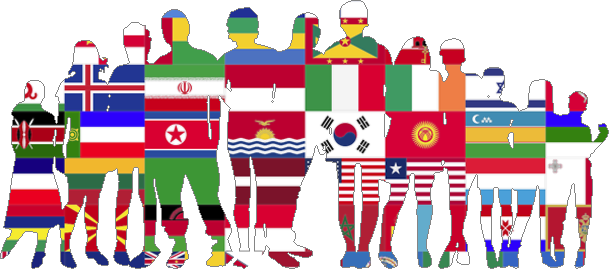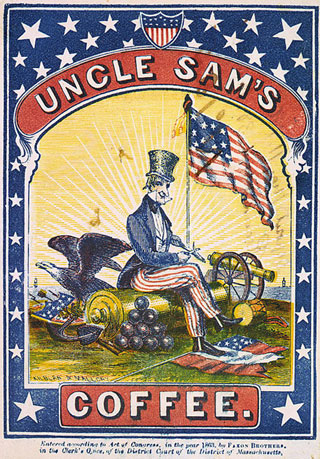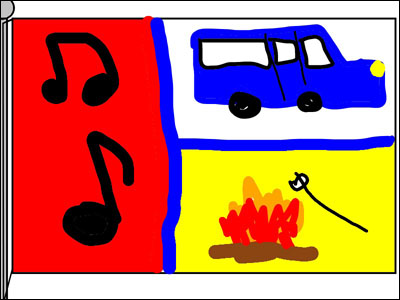
Students explore symbols in the world around them and create a flag that represents the characteristics and values of their family.

You have been learning about how the symbols for a country represent its history and values. Now it’s your turn to apply what you have learned to fashion a flag that represents your family.
A symbol is a picture or object that represents something else, like an idea. They are used to communicate ideas quickly and often have deeper meaning. Have a class discussion about symbols students remember from the United States and what they mean.
Ask students if they can think of any other symbols from the world around them. Remind students about holidays like St. Patrick’s Day, Halloween, or Thanksgiving to spark ideas about images and symbols connected to those events.

You may also want to talk about the colors found in many country flags, such as the red, white, and blue (liberty, equality, fraternity) in French tricorne and other Western flags or the red, black, and green (common blood, people, and land) in many African flags.
Let students know they will be designing a flag with colors and symbols to represent their family. Have students begin by identifying things they feel represent their family and it’s values. Have students use a cluster diagram, like this template from Wixie, to collect their thinking. If students have had experience using a cluster diagram, share an example of a character traits cluster that describes a character in a recent book you have read in class.
Have students share their cluster diagram with families (the people they live with at home or see regularly) in print or digital form. Ask students to have family members help them add notes and ideas after discussing their family together.
Once they have identified words that describe traits and values, the next step is for students to choose which colors and symbols they will use on their family flag.

Color has meaning, but this varies from culture to culture. For example, red is often used for danger and caution, but it symbolizes happiness in China, and mourning in South Africa. Rather than telling your students what colors mean, ask students to tell you what colors mean for them. Collect their responses on your whiteboard or work together to create an anchor chart they can refer to as they are working.
Have students design their flag using a tool like Wixie that allows them to combine painted artwork and clip art images. This makes it easy to get done quickly.
To make evaluating their thinking easier, have students record an explanation of their design choices, sharing the reasons they choose certain colors and symbols.
Print each student’s flag and have them present their design to the class, explaining how the symbols and colors represent things about their family and the things that are important to it.
Create a gallery in your classroom to showcase student flags and host a family night to celebrate all the different ways families are unique. Have students explain their designs to their parents. Since each Wixie project has a unique URL, you could also put up QR codes next to printed flags, so parents can visit the actual project and HEAR the description, much like a museum audio tour.
Use the contents of each student's cluster organizer to have specific conversations with each learner about their choices for colors and symbols that represent their family. You can use the final flag, as well as the audio recording about it, as a summative assessment. This is not an exercise in a showing a single right answer but being able to explain the purpose behind color and symbol choices.
Melissa Ann Ferguson. American Symbols: What You Need to Know ISBN: 1515781275
Norman Pearl. The Great Seal of the United States ISBN: 1404822208
Library of Congress - Symbols of the United States
Infographic - Colors Around the World
CCSS.ELA-LITERACY.RI.K.7
With prompting and support, describe the relationship between illustrations and the text in which they appear (e.g., what person, place, thing, or idea in the text an illustration depicts).
CCSS.ELA-LITERACY.RI.1.6
Distinguish between information provided by pictures or other illustrations and information provided by the words in a text.
3. Knowledge Constructor
Students critically curate a variety of resources using digital tools to construct knowledge, produce creative artifacts and make meaningful learning experiences for themselves and others. Students:
b. evaluate the accuracy, perspective, credibility and relevance of information, media, data or other resources.
c. curate information from digital resources using a variety of tools and methods to create collections of artifacts that demonstrate meaningful connections or conclusions.
6. Creative Communicator
Students communicate clearly and express themselves creatively for a variety of purposes using the platforms, tools, styles, formats and digital media appropriate to their goals. Students:
a. choose the appropriate platforms and tools for meeting the desired objectives of their creation or communication.
b. create original works or responsibly repurpose or remix digital resources into new creations.
d. publish or present content that customizes the message and medium for their intended audiences.

Follow us on Instagram for daily inspiration

Create a thought web, cluster, flowchart, or other graphic organizer for a lesson
8 first projects to get students using technology
Creative, digital book reviews
Fun and powerful ideas with animated characters

Wixie
Share your ideas, imagination, and understanding through writing, art, voice, and video.

Rubric Maker
Create custom rubrics for your classroom.

Pics4Learning
A curated, copyright-friendly image library that is safe and free for education.

Wriddle
Write, record, and illustrate a sentence.

Get creative classroom ideas delivered straight to your inbox once a month.
Topics